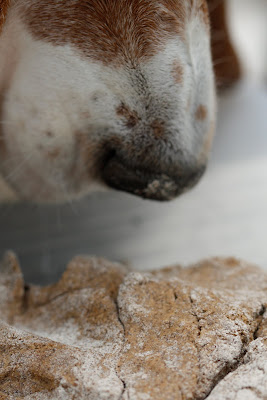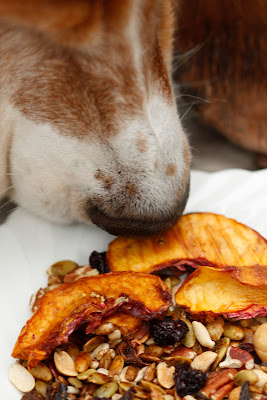 I have a confession to make--I eat dog biscuits. Oh not Milk Bones or any of those "gourmet biscuits" that have faux frosting at pet stores, and I'm not one of those freaky people from "My Strange Addiction," but ever since I started experimenting with nongluten flours and making crackers that my friends called "dog biscuits," I've been addicted.
I have a confession to make--I eat dog biscuits. Oh not Milk Bones or any of those "gourmet biscuits" that have faux frosting at pet stores, and I'm not one of those freaky people from "My Strange Addiction," but ever since I started experimenting with nongluten flours and making crackers that my friends called "dog biscuits," I've been addicted.The biscuits started out as crackers, and in the early days I put them in cute little bags as gifts telling people they were crackers. But even my Cooking Assistant has always acted as if they're dog biscuits that were created just for him.
He could hardly contain himself yesterday when I told him I was making Buckwheat Bones, and when I asked if he'd like to take a picture he was beside himself. He started licking the bowl the minute I set it before him.
These are made with buckwheat, yams and peanut butter--no bacon involved because that really drives him crazy. And I wanted to eat these "crackers," so I stuck with the vegan version--peanut butter and yams.
The basic idea for dog biscuits is you create a liquid with the flavors you want, then add it to the flour mixture. I didn't have any stock, so I just added water. Add additional flour until the dough is very stiff.
If you refrigerate the dough, it becomes more rigid, making it easier to roll out. One cool thing about nongluten flours is you can roll and re-roll and the texture never becomes tough.
Another cool thing about making your own dog biscuits is you can use any kind of cookie cutters you want. I once gave a bag of these crackers to a friend because her kids loved the simple flavor of peanut butter and molasses. A big bonus is they aren't too sweet.
Some dogs don't want to share. That would be my Cooking Assistant. He's just waiting for his share.
 Here's the recipe:
Here's the recipe:
 Here's the recipe:
Here's the recipe:Buckwheat Bones
(Makes about 60 2- to 3-inch biscuits)
3 cups buckwheat flour
3/4 cup tapioca flour or potato starch
1 teaspoon cinnamon
1 cup mashed sweet potatoes or canned pumpkin
3/4 cup peanut butter
1/4 cup blackstrap molasses
Approximately 1 cup water
1/2 cup bacon (optional)
1. Combine dry ingredients in a large mixing bowl. Place sweet potato, peanut butter, molasses and 1/2 cup water in a blender or food processor. Puree until smooth. Add remaining water; then blend with dry ingredients. Add bacon, if desired.
2. Stir until the mixture becomes a stiff dough. Gather into a ball and place in a plastic bag or covered container in the refrigerator for at least one hour. (You can refrigerate this dough up to one week, if you like.)
3. Preheat oven to 350F. Line a few baking sheets with parchment paper. Divide dough in half. Put half in the refrigerator. Roll the other half out to about 1/4-inch thick. Cut with cookie cutters and place as many as you can on a cooking sheet. It doesn't matter if cookies touch.
4. Bake for 35 to 40 minutes. Biscuits should be fairly hard when done. For extra-crispy biscuits leave in the cooling oven for an hour.
It feels a little odd to eat a dog bone shaped biscuit, but the crunch and peanut flavor are what I really like.
Go ahead and make them for "your dog" but I totally get it if you sneak a few of these cool biscuits for yourself.
































